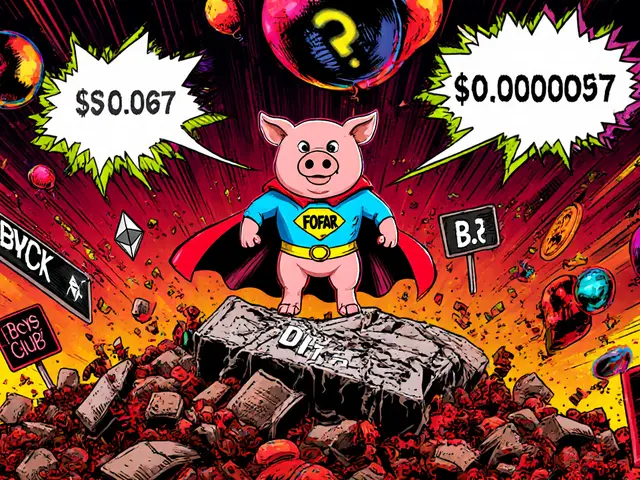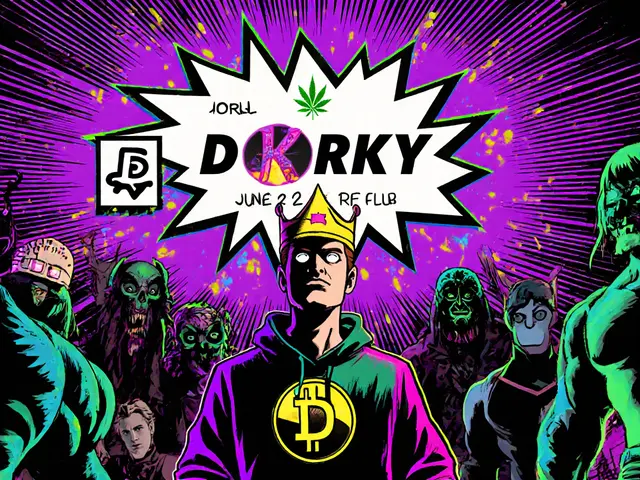Meme Coin Risk Calculator
WARNING: Low-Liquidity Coin Risk
This tool simulates potential losses for coins like FOFAR (FOFAR) with extremely low trading volume. Based on real reports from the article:
- Slippage up to 80% reported when selling on low-volume exchanges
- Price can drop 50% from a single large buy order
- No major exchange support for USD pairs
Risk Assessment Results
If you’ve seen Fofar (FOFAR) pop up on your crypto tracker and wondered if it’s the next big thing, you’re not alone. But here’s the raw truth: Fofar isn’t a project with a roadmap, a team you can verify, or real utility. It’s a meme coin wrapped in confusion, conflicting data, and a story that doesn’t quite add up.
What Exactly Is Fofar (FOFAR)?
Fofar (FOFAR) is a cryptocurrency that claims to be part of the Boys Club universe - the same art collective behind Pepe the Frog, created by artist Matt Furie. According to its website, fofar.com, it’s marketed as "the last official Boys Club member memecoin," with a rebel pig as its mascot. Sounds fun, right? But there’s no public confirmation from Matt Furie or his team that they’re involved. That’s a red flag. Meme coins often borrow pop culture imagery to attract attention, but legitimacy matters.
Technically, FOFAR is supposed to be an ERC-20 token on the Ethereum blockchain. But here’s the first twist: some sites say it’s on Tron. CoinGecko, CoinMarketCap, and CoinCodex all list conflicting information. One says Ethereum. Another says Tron. Both give you the same total supply: 420.69 billion tokens. That’s not a typo - it’s a meme number, chosen to match the infamous 420 culture. But if the blockchain is unclear, how can you trust anything else?
Price Chaos: Why No One Agrees on FOFAR’s Value
FOFAR’s price is a mess. On CoinMarketCap (as of mid-2024), it was trading at $0.0000006748. On CoinCarp, it was $0.000158 - over 200 times higher. CoinCodex had it at $0.000001451. These aren’t minor differences. They’re impossible to reconcile.
Why? Because FOFAR is listed on tiny, unregulated exchanges like Dex-Trade, CoinW, and Hotcoin Global. None of them are major platforms like Binance or Coinbase. That means there’s almost no real trading volume. CoinMarketCap reported $0 in 24-hour volume. CoinCarp claimed $202.41. That’s not liquidity - that’s a handful of people moving tokens around in circles.
And here’s the scary part: with such low volume, one person buying 10 million FOFAR can spike the price by 50%. Then they sell. That’s called a pump-and-dump. And there are dozens of Reddit and Twitter posts from people who tried to sell and lost 80% of their value to slippage.
The Meme Arcade Promise - And Why It Doesn’t Exist
FOFAR’s website talks about a "Meme Arcade" - a decentralized gaming platform where you can play games and earn tokens. Sounds cool? It’s fiction. No one has seen it. No developers have built it. No GitHub repo. No beta test. No screenshots. Just a line on the homepage.
Other meme coins like Dogecoin or Shiba Inu have real communities, real use cases, and even real partnerships. FOFAR? Its entire "utility" is based on a fantasy. The same goes for its "Meme Super Community" - a term thrown around by some review sites. But if you join its Telegram group (2,831 members as of mid-2024), you’ll find mostly hype posts, memes, and zero updates on any platform development.

Who’s Behind Fofar? No One Knows
There’s no whitepaper. No team page. No LinkedIn profiles. No Twitter account linked to verified founders. MEXC’s analysis says there’s "an active team," but doesn’t name them. That’s not normal. Even the most chaotic meme coins like Pepe have known developers or at least pseudonymous leads.
And the contract? FOFAR claims to have "burned liquidity and renounced ownership." That means the creators can’t just drain the wallet and run. But Etherscan - Ethereum’s public blockchain explorer - shows no clear evidence of this. The contract address is live, but no one has verified the renouncement. That’s like buying a car with no title. You think it’s yours, but the real owner could show up at any time.
Market Reality: FOFAR Is a Tiny Fish in a Big Ocean
As of mid-2024, FOFAR ranked #7,915 by market cap on CoinMarketCap. Its market cap hovered around $720,000. Compare that to Dogecoin at $24 billion or Shiba Inu at $9.8 billion. FOFAR is 33,000 times smaller. It has only 2,810 token holders. Shiba Inu has over 1.2 million.
It’s not just small - it’s irrelevant in the broader crypto market. It doesn’t appear in any major wallet apps. It’s not supported by any payment processors. No one uses it to buy coffee, games, or NFTs. It exists only as a speculative bet on a future that may never come.
What Do Experts Say?
Technical analysts are bearish. CoinCodex’s June 2024 report predicted a 25% price drop in the next 75 days. CryptoQuant’s survival model gave FOFAR just a 38.7% chance of still being tradable by early 2025. That’s not a prediction - it’s a warning.
Independent crypto analysts on Twitter and Reddit have called it a "wash trading experiment" and a "multi-contract scam." One user on r/CryptoCurrency shared: "I bought FOFAR because it looked cheap. Sold 10 minutes later at 70% loss. Slippage ate my profits before I even clicked confirm."
And here’s the kicker: the website fofar.com was last updated in March 2024. The Telegram channel hasn’t posted anything meaningful since June 2024. The Twitter account has been quiet for weeks. That’s not a project in development. That’s a project in hibernation - or worse, abandoned.

Should You Buy FOFAR?
If you’re looking for a long-term investment? No. FOFAR has no fundamentals, no team, no utility, and no real liquidity.
If you’re looking for a high-risk gamble? Maybe - but only if you treat it like buying a lottery ticket. Put in $5. Not $500. Not $5,000. And know this: if the price goes up, it’s because someone else is buying, not because the coin has value. When the hype dies - and it will - you’ll be stuck with tokens no one wants.
There’s no way to cash out without massive losses. Exchanges don’t support USD pairs. You can’t trade it for Bitcoin or Ethereum without paying huge fees and slippage. Even MetaMask can’t help you if the market doesn’t exist.
Final Verdict
FOFAR isn’t a crypto coin. It’s a meme wrapped in technical noise and marketing fluff. It uses Pepe the Frog’s image to look legit. It uses blockchain jargon to sound smart. But behind it? Nothing.
There’s no innovation. No community. No future. Just a bunch of numbers on a screen, hoping someone will pay more for them tomorrow.
If you’re curious, go ahead and check fofar.com. But don’t invest anything you can’t afford to lose. And if you already own it? Don’t wait for the moon. Sell small, if you can. The longer you hold, the harder it gets to get out.
What to Do Instead
If you like meme coins, stick to ones with real volume, real listings, and real communities: Dogecoin, Shiba Inu, or even newer ones like Bonk or PEPE - all of which are on Binance, Coinbase, and Kraken. They’re still risky, but at least you know where you stand.
Don’t chase hype. Don’t follow Telegram influencers. Don’t buy a coin because it "feels right." Crypto isn’t luck. It’s research. And FOFAR? It doesn’t pass even the most basic test.


